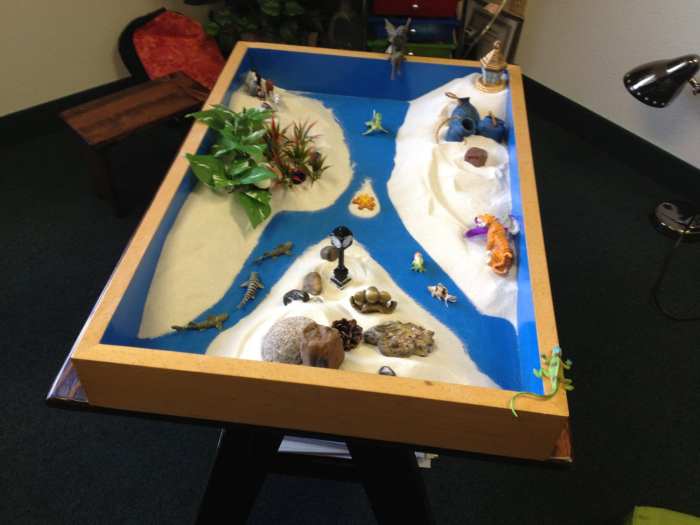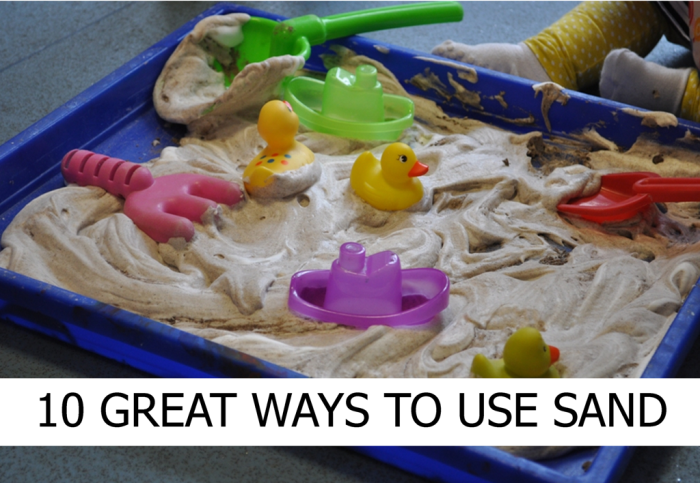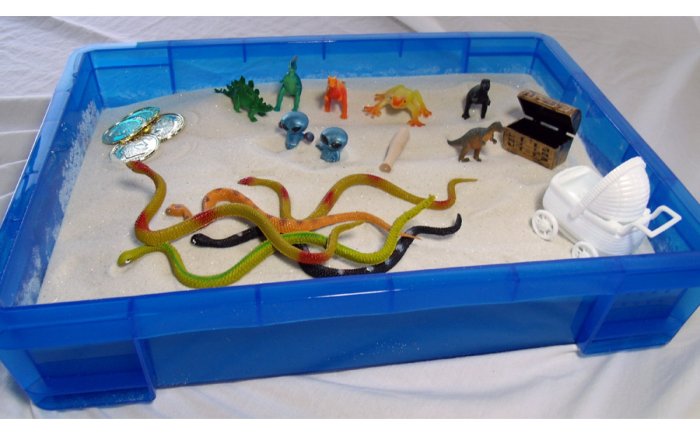Unleash the therapeutic and educational power of sand tray ideas! Join us as we delve into the world of sand tray therapy, exploring its diverse techniques, essential materials, and profound applications. From assessing psychological dynamics to enhancing creativity in educational settings, sand trays offer a captivating medium for self-expression, healing, and growth.
Throughout this journey, we’ll unravel the symbolism and interpretation of sand tray elements, discover how sand trays aid in psychological assessment, and witness the transformative power of sand tray interventions for addressing various mental health concerns.
Sand Tray Techniques

Sand tray therapy is a type of expressive therapy that uses a sandbox filled with sand and a variety of miniature objects to facilitate self-expression and exploration.
There are a variety of sand tray techniques that can be used for different therapeutic purposes. Some of the most common techniques include:
- Free play:In free play, the client is given the freedom to create whatever they want in the sand tray. This can be a helpful way to explore inner thoughts and feelings, and to gain insight into the client’s inner world.
- Directed play:In directed play, the therapist gives the client specific instructions about what to create in the sand tray. This can be a helpful way to explore specific issues or themes, and to help the client develop new coping mechanisms.
- Symbolic play:In symbolic play, the client uses the miniature objects in the sand tray to represent people, places, and things in their life. This can be a helpful way to explore complex relationships and dynamics, and to gain insight into the client’s unconscious mind.
The symbolism of the sand tray elements can vary depending on the individual client and the context of the therapy session. However, some common symbols include:
- Sand:The sand can represent the unconscious mind, the body, or the world in general.
- Water:Water can represent emotions, the flow of life, or purification.
- Objects:The objects in the sand tray can represent people, places, things, or concepts that are important to the client.
The interpretation of the sand tray elements is a complex process that requires training and experience. However, by understanding the basic symbolism of the elements, therapists can help clients to gain insight into their inner world and to develop new coping mechanisms.
Sand Tray Materials
Sand tray therapy relies on specific materials to create a safe and expressive space for clients. These materials include sand, miniatures, and trays, each carefully selected to facilitate exploration and insight.
Sand
Sand is the primary medium in sand tray therapy, providing a tangible and versatile canvas for clients to express their thoughts, feelings, and experiences. The texture and fluidity of sand allow for both structured and free-form play, encouraging clients to tap into their subconscious minds.
Miniatures
Miniatures are small-scale representations of people, objects, and environments that clients can use to create their sand tray worlds. These miniatures come in a wide variety of forms, from realistic figures to abstract shapes, allowing clients to symbolize their experiences and explore their inner landscapes.
Trays
Trays provide a contained space for clients to create their sand tray worlds. They can be made of various materials, such as wood or plastic, and come in different sizes and shapes. The size of the tray can influence the scale and complexity of the sand tray world, while the shape can encourage specific themes or perspectives.
Sand Tray Assessment

Sand trays, filled with sand and miniature objects, offer a safe and expressive medium for psychological assessment. Therapists observe clients as they create scenes in the sand, gaining insights into their subconscious thoughts, feelings, and conflicts.
Identifying Client Dynamics and Issues
Sand tray analysis helps identify patterns and themes in clients’ creations. Therapists consider the objects chosen, their arrangement, and the narrative created by the client. This analysis reveals unconscious conflicts, relationship dynamics, defense mechanisms, and coping strategies. By interpreting these elements, therapists gain a deeper understanding of the client’s inner world and the issues they are facing.
Sand Tray Interventions

Sand tray interventions provide a non-verbal and creative medium for clients to explore their inner world and address mental health concerns. By using sand, miniature figures, and other objects, clients can create scenes that represent their thoughts, feelings, and experiences.
Sand tray interventions can be used to address a wide range of mental health concerns, including:
Trauma
- Provide a safe and contained space for clients to explore traumatic memories.
- Help clients to identify and process emotions related to trauma.
- Facilitate the development of coping mechanisms for managing trauma symptoms.
Anxiety
- Help clients to identify and understand their anxiety triggers.
- Provide clients with tools for managing anxiety symptoms.
- Facilitate the development of relaxation and coping skills.
Relationship Issues
- Help clients to identify and explore relationship patterns.
- Provide clients with insights into their own and others’ perspectives.
- Facilitate the development of communication and conflict-resolution skills.
Sand Tray with Children
Sand tray therapy provides a safe and non-threatening environment for children to express their thoughts and feelings. It allows them to explore their inner world, develop self-awareness, and work through difficult experiences.
When working with young clients, it’s important to adapt sand tray techniques to their developmental needs. Here are some tips:
Using Miniatures
Choose miniatures that are familiar and relatable to the child. Start with a few simple figures and gradually add more as the child becomes more comfortable with the process.
Creating a Safe Space
Establish clear boundaries and rules for the sand tray. Encourage the child to express themselves freely, but also remind them that the sand tray is a safe space where they can explore their thoughts and feelings without judgment.
Facilitating Exploration
Ask open-ended questions to encourage the child to talk about their creations. Pay attention to the themes and patterns that emerge, and use these to help the child understand their own experiences.
Processing the Experience
After the sand tray session, talk to the child about what they created. Help them to make connections between the sand tray world and their own life. Encourage them to reflect on their experiences and identify any insights they have gained.
Sand Tray with Groups
Sand tray therapy is a versatile technique that can be used effectively in both individual and group settings. In group settings, sand tray therapy provides a shared space for participants to explore their thoughts, feelings, and experiences in a safe and supportive environment.The
dynamics of group sand tray work can be complex and challenging, but also incredibly rewarding. The presence of multiple participants can create a sense of community and belonging, while also providing opportunities for collaboration, feedback, and support. However, it is important to note that group sand tray work requires careful planning and facilitation to ensure that all participants feel safe and respected.
Challenges
One of the challenges of group sand tray work is managing the different needs and perspectives of participants. It is important to create a space where all participants feel comfortable sharing their creations and interpretations, while also respecting the boundaries of others.
Another challenge is ensuring that the group remains focused and productive, while also allowing for spontaneity and creativity.
Sand Tray in Educational Settings
Sand trays have found a niche in educational settings, offering unique opportunities for learning and creative expression.
In schools, sand trays can be used as a tool for:
- Promoting literacy and language development through storytelling and creative writing.
- Enhancing math and science concepts through hands-on exploration and representation.
- Fostering social and emotional learning by providing a safe and non-threatening environment for self-expression and group collaboration.
In universities, sand trays can be used as a research tool for:
- Exploring developmental processes and psychological dynamics.
- Investigating the impact of trauma and adversity on children.
- Evaluating the effectiveness of therapeutic interventions.
Sand Tray in Higher Education
In higher education, sand trays are increasingly being used in:
- Teacher education programs to prepare future teachers to use sand trays in their classrooms.
- Counseling and psychology programs to train students in the use of sand trays for therapeutic purposes.
- Art therapy programs to explore the creative and expressive potential of sand trays.
Sand Tray Table Design

Designing and building a sand tray table is essential for successful sand tray therapy. Here are some guidelines to consider:
Table Size
The table should be large enough to accommodate the sand tray and allow for ample space for the client to work comfortably. A typical size for a sand tray table is 30 inches wide by 24 inches deep by 3 inches high.
Materials
The table should be made of sturdy materials that can withstand frequent use. Wood or metal are good choices. The surface of the table should be smooth and non-porous to prevent sand from getting trapped.
Lighting
Proper lighting is important for sand tray therapy. The table should be placed in a well-lit area or have a built-in light source. Natural light is preferred, but artificial light can also be used.
Sand Tray Case Studies
Sand tray therapy has demonstrated effectiveness in a variety of clinical settings. Here are some case studies that highlight its benefits:
Case Study: Child with Trauma
A 6-year-old girl who had experienced trauma was struggling with nightmares, anxiety, and difficulty regulating her emotions. Sand tray therapy provided a safe and non-verbal outlet for her to express her experiences. Through the use of miniatures, she created scenes that represented her feelings of fear, anger, and sadness.
The therapist used the sand tray to help her process her emotions and develop coping mechanisms.
Case Study: Adult with Depression, Sand tray ideas
A 30-year-old woman with depression was struggling with feelings of worthlessness and hopelessness. Sand tray therapy allowed her to explore her negative thoughts and feelings in a creative and symbolic way. She created scenes that depicted her sense of isolation and despair.
The therapist used the sand tray to help her challenge her negative beliefs and develop a more positive self-image.
Case Study: Group Therapy for Veterans
A group of veterans who had experienced combat trauma were struggling with symptoms of PTSD. Sand tray therapy provided a safe and supportive environment for them to process their experiences and connect with each other. They created scenes that represented their memories of combat, their feelings of loss and grief, and their hopes for the future.
The therapist used the sand tray to help them process their trauma and develop coping mechanisms.
Outcome Summary
As we conclude our exploration of sand tray ideas, we leave you with a deep appreciation for its versatility and therapeutic potential. Whether in individual sessions, group settings, or educational environments, sand trays continue to inspire, heal, and empower. Embrace the therapeutic journey and witness the transformative power of this creative medium.
Expert Answers: Sand Tray Ideas
What is sand tray therapy?
Sand tray therapy is a therapeutic technique that uses a sand-filled tray and miniature objects to facilitate self-expression, exploration, and healing.
How is sand tray therapy used in education?
Sand tray therapy can be used in educational settings to enhance creativity, promote self-expression, and support social-emotional learning.
What are the benefits of sand tray therapy?
Sand tray therapy offers numerous benefits, including improved self-awareness, reduced stress, enhanced coping mechanisms, and increased creativity.


